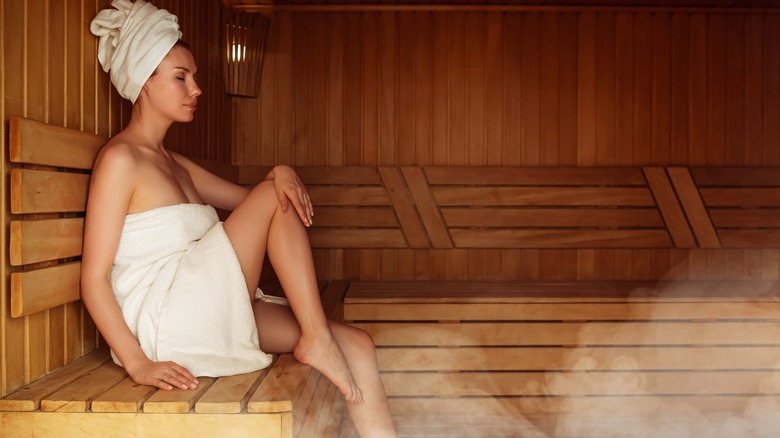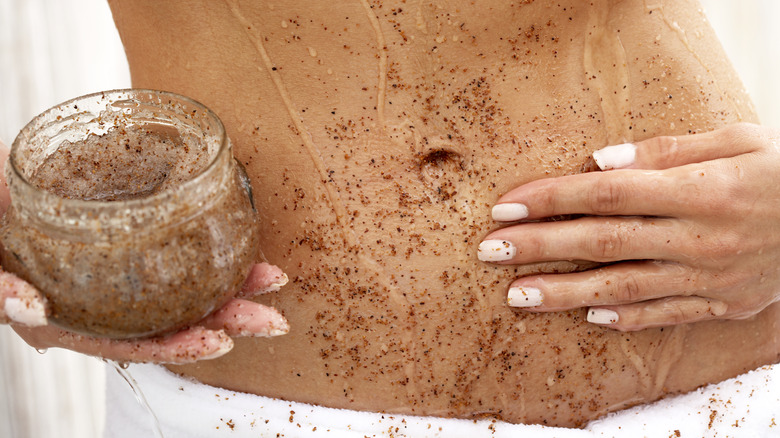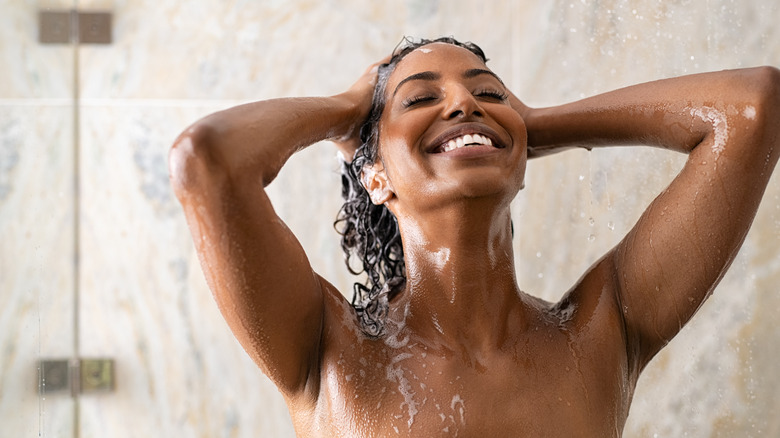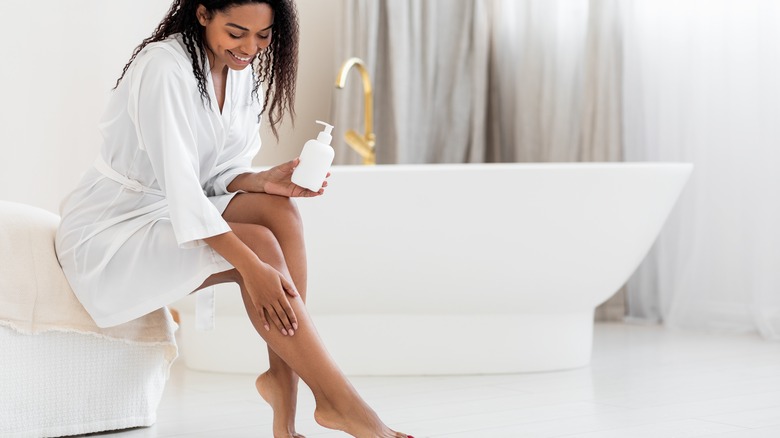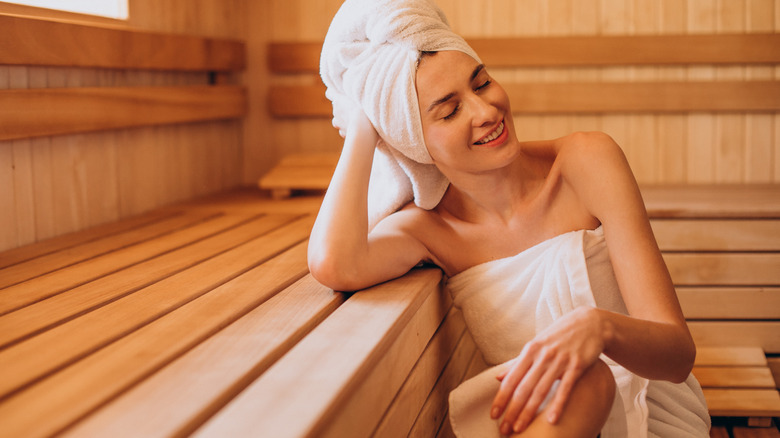Skincare Expert Explains How To Prep Your Skin To Get The Most Out Of Your Sauna Time
We may receive a commission on purchases made from links.
Saunas are associated with relaxation and recovery from exercise, along with several very real health benefits. Spending even just a brief amount of time in a hot sauna dilates blood vessels and stimulates circulation while helping to relax stiff muscles and ease aches and pains (via GoodRx). When it comes to skin health, however, your sauna experience may vary. While some people do report improvements in skin conditions like psoriasis, others may find that the dry heat results in excessive moisture loss.
If you've been dying to try out a sauna but don't want to dry out your skin, never fear. Glam spoke with expert esthetician and makeup artist Sonia Roselli to find out exactly how to prepare and protect your skin when you're headed for the dry heat experience so you can do so with relaxation and ease. Here's what you can do to reap the benefits of a sauna while retaining your skin's natural moisture.
Step one: exfoliate
About 24 hours before you expect to spend time in a sauna, Sonia Roselli recommends that you exfoliate your skin. "Give your skin a little TLC," she elaborates. "Exfoliate a day before your sauna session to slough off dead skin cells and reveal your smooth and radiant skin. Then follow up with a body and facial oil after your exfoliation. Then, the next day, you're ready for your sauna experience."
There are two ways to exfoliate: mechanically and chemically. Mechanical exfoliation uses a physical tool like a loofah, granules, or a brush to remove dead skin cells. Chemical exfoliation relies upon acids to dissolve them. If you already have an exfoliation routine, now probably isn't the best time to try something new. If you're completely new to exfoliating, consider starting with a gentle exfoliating mitt rather than experimenting with new chemicals right before your sauna experience. Easy enough, right?
Step two: cleanse
Before you even think about stepping foot into a sauna, opt for a nice warm shower where you can gently cleanse your skin from your scalp down to your toes. "Take a shower and give your skin a good, gentle cleanse. Don't use gel cleansers or cleansers that sud," Sonia Roselli advises. "This will help get rid of any dirt, grime, or sweat, and get those pores open and ready to soak up the sauna's goodness. For the face, use a gentle oil cleanser or cream cleanser and make sure all your makeup is removed."
If you've been on the hunt for a super gentle way to cleanse your face and remove your makeup in one step without disturbing the skin barrier, Roselli recommends Japanese cleansing oil. A healthy skin barrier is key to preventing transepidermal water loss when exposing yourself to the high heat and low moisture environment of a sauna.
Step three: hydrate
Any time you expose your body to high temperatures, water is lost through sweating. This loss is amplified by the dry atmosphere of a sauna, though you may not notice thanks to the dry air speeding up the rate of evaporation. Sonia Roselli recommends that you "slather on some super hydrating moisturizer before and after your sauna session to keep your skin hydrated and supple while you relax."
To combat dehydration, be sure to also hydrate from within by drinking extra water leading up to your session. Mineral water or water with added electrolytes may provide you with a bit of extra hydration power. As far as immediate effects on your skin, "use a creamy, water-rich body lotion to keep the body's skin supple," Sonia specifies, and "don't forget your feet too!" Roselli recommends Aveda Foot Relief to keep your tootsies soft and hydrated throughout your sauna experience and beyond.
Step four: protect
Just like your skin uses a barrier to protect it from moisture loss and irritants, you can add a layer of protection from the dry heat of the sauna. "The heat in a sauna can be rough on your face, especially for certain skin types, causing redness and irritation," Sonia Roselli explains. "Pop on a hat or wrap a towel around your head to keep your face protected." If you're a serious sauna-goer who plans to make it a routine, consider buying yourself an actual sauna hat, designed to help cool the head and prevent overheating.
"We want to be sure we don't cause any unnecessary transepidermal water loss," Roselli continues. "This is why moisturizer is so important, especially with occlusive ingredients in it like squalene or dimethicone. If you tend to get redness on your chest, lay a dry cloth over your chest too to protect from the heat." While most public saunas will offer towels on-site, you can typically also opt to bring your own. Look for a sauna towel made of light linen material that won't contribute to further raising your body temperature.
A note on fragrances
Sonia Roselli doesn't recommend using scented products of any kind on your skin before visiting a sauna. "Leave the perfumes and colognes at home," she instructs, "as these can irritate your skin and cause unwanted, unintended reactions." If you're bummed that you won't be able to include aromatherapy in your relaxation secession, don't fret. Saunas are typically constructed using natural woods like cedar and eucalyptus, which emit a woodsy scent all their own, known to aid in relaxation.
If you're planning to use a privately owned sauna, you may have the option of adding a few drops of the essential oil of your choice to the water bucket to further enhance the scent and aromatherapy benefits. Just be sure to stick to oils you're familiar with to avoid any potential skin reactions that could cancel out all the hard work you've put into your pre-sauna skin preparation and protection routine.
